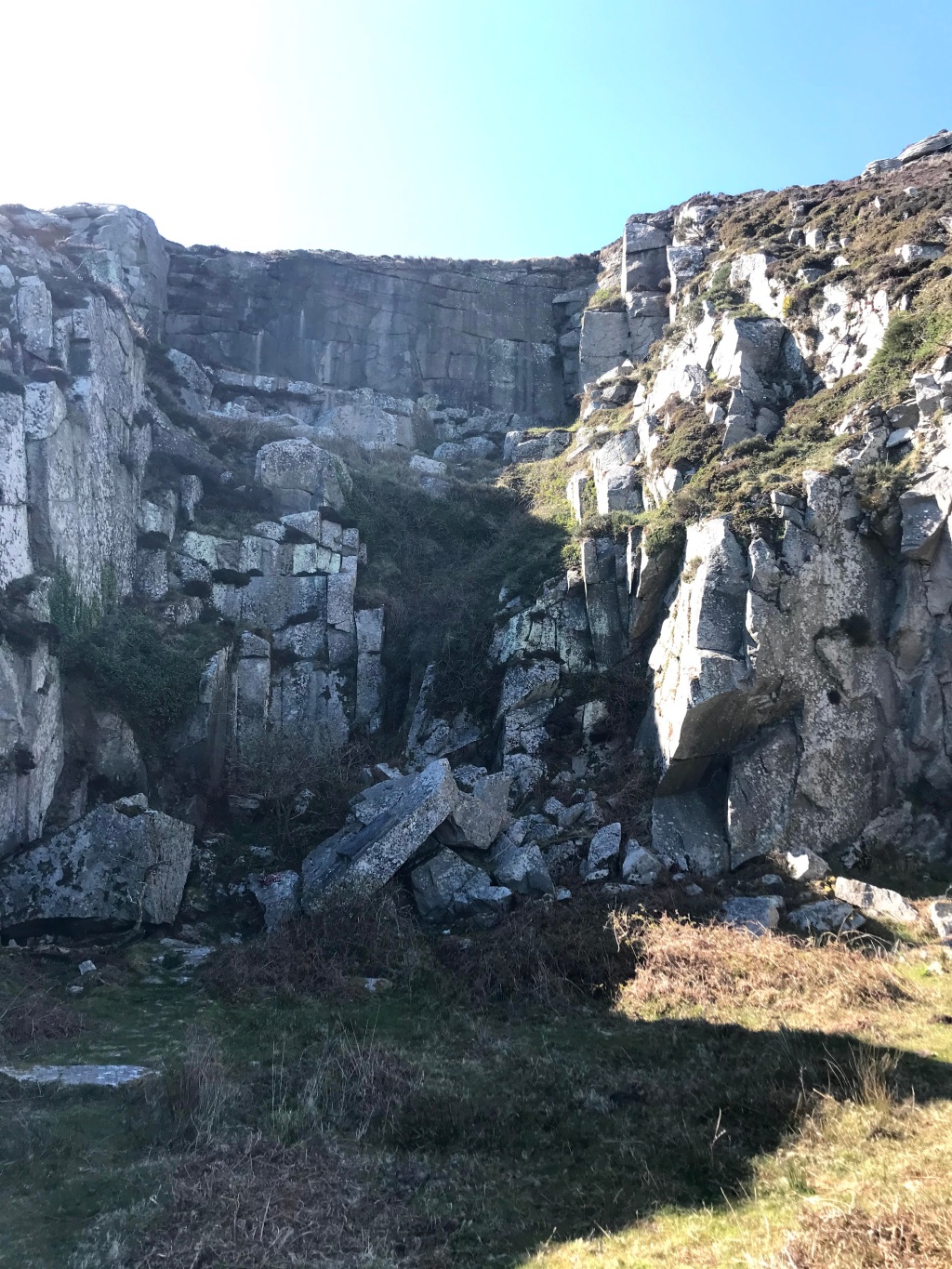My travels often take me to Lundy, I like many others are drawn to this granite rock in the middle of the Bristol Channel. On my latest visit it was the quarries on the east side of the Island that were my intended destination for a walk.
This desire to engage with the quarry was stimulated when it was suggested in a tutorial, that I look at the work of artist Katrina Palmer. Katrina Palmer’s work The Loss Adjusters focusses on deviant goings-on in the history of Portland Stone. There are many similar narratives around the Lundy Granite Company and the management of the Lundy Granite Company which was set up in 1863. At the time of the quarry activity, there were between 200-400 men on this tiny island which usually housed around 17 inhabitants including the Owner of lundy his family and lighthouse keepers. The men employed by the Lundy Granite Company found little to stimulate them and were often drunk and disorderly, as retold by Ternstrom, M., (2008).
“it was complained that Ryan, the engineer , was continually drunk and abusive. It was perhaps inevitable that with some 200 workmen, laxly supervised, on an island with very few sources of recreation apart from the canteen, there would have been fights, disturbances and damages. When one case came to Bideford court in 1865 the judge said that Lundy was; ‘….a refuge for the destitute .. the fag ends of society’
Like the Portland stone in Palmer’s Loss Adjusters, Lundy Granite was in demand for building parts of London, Palmer re tells the narrative around the quarries and how Portland stone had been shaped and hollowed out over centuries by convicts and quarrymen to provide stone for some of London’s best-known buildings – one million square feet of Portland stone is said to have been quarried for St Paul’s Cathedral alone.

One is confronted with the juxtaposition in history when walking past middle quarry, which once full of quarrymen it is now named VC quarry, renamed in memorial to John Pennington Harman, awarded a posthumous Victoria Cross for his actions during the Burma Campaign. (The Quarry was one of his favourite places when a boy on the island).
Whilst in the quarries it was my intention to explore being in the landscape, rather than just being an observer. Stephens (2000) refers to the work of Peter Lanyon when he talks of how Lanyon integrated with the landscape when creating artworks;
the Artists use of the experience of space and time as the source for his painting also Incorporated the historical experience of the place and it’s people. This was not just a question of the countryside holding the deposits of earlier occupation but of its contents embodying a human past. ‘Rock and and boulders’ he said (lanyon) ‘are touched by centuries of work and life. For me they’re stones with a human history and meaning’
One cannot fail to be mesmerized by the granite as on a sunny day the whole island glistens from the minerals within the granite, the silvery coloured mica contrasting against the black, white crystals of feldspar and greyish transparent quartz crystals. Whilst researching the concept of geology and the landscape I discovered the work of Tania Kovats whose practice is inspired by rocks and the whole concept of geology
The landscapes that interest me the most are geologically explicit landscapes where you can clearly read the narrative of formation or erosion. This leads me to be working with landscapes that are often remote – cliff edges, deserts, odd geological incidents. The way our experience of landscape is culturally mediated is of central concern to me. Much of my thinking over the last few years has meant I have looked to geology to help read landscape to further understand how landscapes are made outside of what we effect upon them. No landform exists forever but only within a particular time span in the earth’s history. I see landscape as a series of incidents coming into being.’ Kovats (n/d)
The geology that surrounds granite is intriguing as can be seen by the microscoped view below of a piece of granite below. This is definitely something I wish to investigate further with my work.
Fortunately for the Lundy of today, the quarries did not prove that successful commercially and were badly managed as recounted by Ternstrom and thus only mined for 6 years. What interests me is the devastation that might have been experienced on this Island, if they had been successful. The quarries now resemble dramatic amphitheatres looking out to the North Devon Coastline, whose stories are hidden in the rocks.
References
Granite – Lundy (no date). [Online]. Available at https://www.virtualmicroscope.org/content/granite-lundy. [Accessed on 22/04/2021]
Tania Kovats (no date). [Online]. Available at https://land2.leeds.ac.uk/people/kovats/. [Accessed on 22/04/2021]
Stephens, C., (2000). Peter Lanyon: At the edge of landscape. 21 Publishing London.
Ternstrom, M., (2008). The Lundy Granite Company: An Industrial Adventure. Westwell Publishing.
